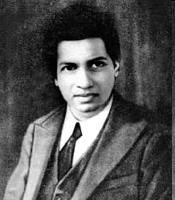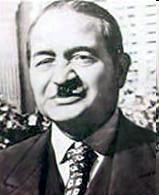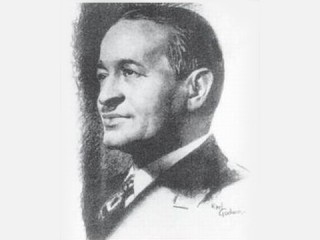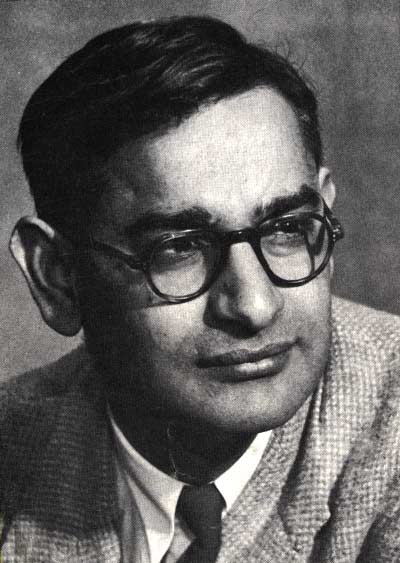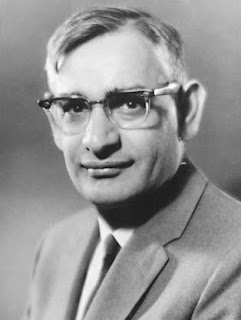
Srinivasa Aiyangar Ramanujan was born on December 22, 1887 in Erode, Tamil Nadu. His father worked in Kumbakonam as a clerk in a cloth merchant's shop. At the of five Ramanujan went to primary school in Kumbakonam. In 1898 at age 10, he entered the Town High School in Kumbakonam. At the age of eleven he was lent books on advanced trigonometry written by S. L. Loney by two lodgers at his home who studied at the Government college. He mastered them by the age of thirteen. Ramanujan was a bright student, winning academic prizes in high school.
While at school he came across a book entitled A Synopsis of Elementary Results in Pure and Applied Mathematics by George Shoobridge Carr. The title of the book does not reflect its contents. It was a compilation of about 5000 equations in algebra, calculus, trigonometry and analytical geometry with abridged demonstrations of the propositions. Carr had compressed a huge mass of mathematics that was known in the late nineteenth century within two volumes. Ramanujan had the first one. It was certainly not a classic. But it had its positive features. According to Kanigel, one strength of Carrs book was a movement, a flow to the formulas seemingly laid down one after another in artless profusion that gave the book a sly seductive logic of its own. Thisbook had a great influence on Ramanujans career. However, the book itself was not very great. Thus Hardy wrote about the book: He (Carr) is now completely forgotten, even in his college, except in so far as Ramanujan kept his name alive. He further continued, The book is not in any sense a great one, but Ramanujan made it famous and there is no doubt it influenced him (Ramanujan) profoundly. We do not know how exactly Carrs book influenced Ramanujan but it certainly gave him a direction. `It had ignited a burst of fiercely single-minded intellectual activity. Carr did not provide elaborate demonstration or step by step proofs. He simply gave some hints to proceed in the right way. Ramanujan took it upon himself to solve all the problems in Carrs Synopsis. And as E. H. Neville, an English mathematician, wrote : In proving one formula, as he worked through Carrs synopsis, he discovered many others, and he began the practice of compiling a notebook. Between 1903 and 1914 he had three notebooks.
At age of 16 his life took a decisive turn after he obtained a book titled" A Synopsis of Elementary Results in Pure and Applied Mathematics". The book was simply a compilation of thousands of mathematical results, most set down with little or no indication of proof. The book generated Ramanujan's interest in mathematics and he worked through the book's results and beyond. By 1904 Ramanujan had begun to undertake deep research. He investigated the series (1/n) and calculated Euler's constant to 15 decimal places. He began to study the Bernoulli numbers, although this was entirely his own independent discovery. He was given a scholarship to the Government College in Kumbakonam which he entered in 1904. But he neglected his other subjects at the cost of mathematics and failed in college examination. He dropped out of the college.
Ramanujan lived off the charity of friends, filling notebooks with mathematical discoveries and seeking patrons to support his work. In 1906 Ramanujan went to Madras where he entered Pachaiyappa's College. His aim was to pass the First Arts examination which would allow him to be admitted to the University of Madras. Continuing his mathematical work Ramanujan studied continued fractions and divergent series in 1908. At this stage he became seriously ill again and underwent an operation in April 1909 after which he took him some considerable time to recover.
On 14 July 1909 Ramanujan marry a ten year old girl S Janaki Ammal. During this period Ramanujan had his first paper published, a 17-page work on Bernoulli numbers that appeared in 1911 in the Journal of the Indian Mathematical Society. In 191,1 Ramanujan approached the founder of the Indian Mathematical Society for advice on a job. He got the job of clerk at the Madras Port Trust with the help of Indian mathematician Ramachandra Rao.
The professor of civil engineering at the Madras Engineering College C L T Griffith was interested in Ramanujan's abilities and, having been educated at University College London, knew the professor of mathematics there, namely M J M Hill. He wrote to Hill on 12 November 1912 sending some of Ramanujan's work and a copy of his 1911 paper on Bernoulli numbers. Hill replied in a fairly encouraging way but showed that he had failed to understand Ramanujan's results on divergent series. In January 1913 Ramanujan wrote to G H Hardy having seen a copy of his 1910 book Orders of infinity. Hardy, together with Littlewood, studied the long list of unproved theorems which Ramanujan enclosed with his letter. Hardy wrote back to Ramanujan and evinced interest in his work.
University of Madras gave Ramanujan a scholarship in May 1913 for two years and, in 1914, Hardy brought Ramanujan to Trinity College, Cambridge, to begin an extraordinary collaboration. Right from the start Ramanujan's collaboration with Hardy led to important results. In a joint paper with Hardy, Ramanujan gave an asymptotic formula for p(n). It had the remarkable property that it appeared to give the correct value of p(n), and this was later proved by Rademacher.
Ramanujan had problems settling in London. He was an orthodox Brahmin and right from the beginning he had problems with his diet. The outbreak of World War I made obtaining special items of food harder and it was not long before Ramanujan had health problems.
On 16 March 1916 Ramanujan graduated from Cambridge with a Bachelor of Science by Research. He had been allowed to enrol in June 1914 despite not having the proper qualifications. Ramanujan's dissertation was on Highly composite numbers and consisted of seven of his papers published in England.
Ramanujan fell seriously ill in 1917 and his doctors feared that he would die. He did improve a little by September but spent most of his time in various nursing homes. On February 18, 1918 Ramanujan was elected a fellow of the Cambridge Philosophical Society and later he was also elected as a fellow of the Royal Society of London. By the end of November 1918 Ramanujan's health had greatly improved.
Ramanujan sailed to India on 27 February 1919 arriving on 13 March. However his health was very poor and, despite medical treatment, he died on April 6, 1920.

